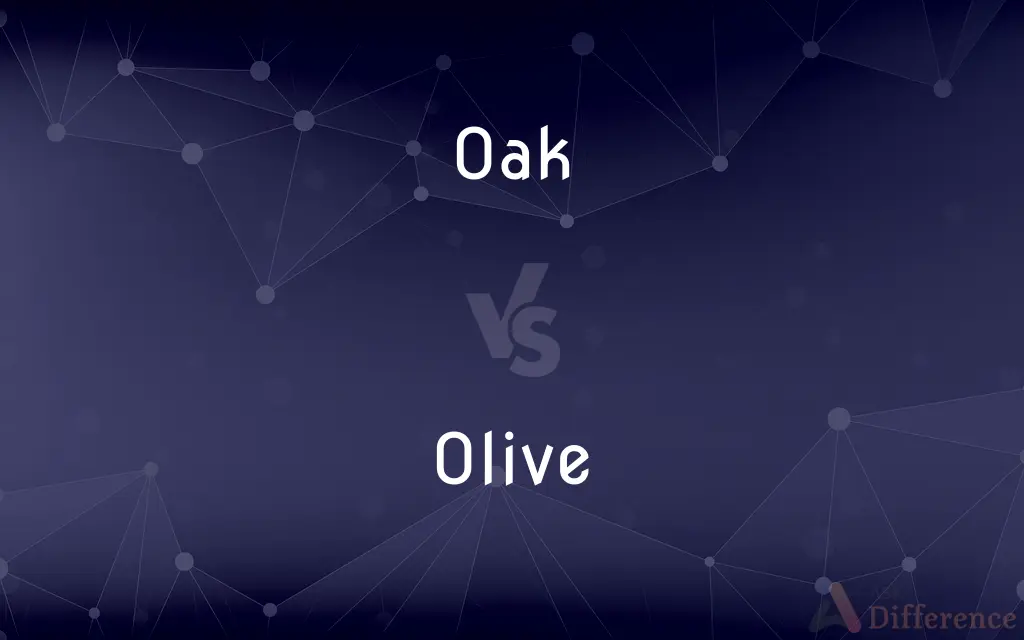Oak vs. Olive — What's the Difference?
Edited by Tayyaba Rehman — By Fiza Rafique — Updated on March 7, 2024
Oak and Olive trees differ significantly; oaks are known for their strength and hardwood, while olives are prized for their fruit and oil.

Difference Between Oak and Olive
Table of Contents
ADVERTISEMENT
Key Differences
Oak trees, belonging to the genus Quercus, are known for their durable hardwood and play a significant role in furniture making and flooring due to their strength and longevity. On the other hand, olive trees, from the genus Olea, specifically the species Olea europaea, are cultivated primarily for their fruit and the oil extracted from it, which is a staple in diets and cuisines worldwide, especially in the Mediterranean region.
While oaks are celebrated for their symbolic strength and the variety of species found across many temperate climates, olive trees are revered for their historical, economic, and cultural significance, particularly in regions like the Mediterranean where they have been an essential part of life for thousands of years. Olives symbolize peace and prosperity and are integral to the agricultural landscape of these areas.
Oak trees also have ecological significance, providing habitat and food for various wildlife species. They are known for their slow growth, which contributes to the wood's density and strength. In contrast, olive trees are valued for their resilience, able to thrive in rocky, nutrient-poor soils and withstand drought conditions, making them symbols of endurance and vitality.
The distinction extends to their uses; oak wood is sought after in construction and crafting for its aesthetic and physical properties, including resistance to pests and decay. Meanwhile, olives and their oil are indispensable in culinary applications, health, and beauty products, highlighting the nutritional and medicinal benefits of the olive fruit and oil.
Despite their differences, both oak and olive trees have long lifespans and historical significance, with ancient trees often becoming landmarks or symbols. The choice between oak and olive depends on the context, whether one values the trees for their material properties, like strength and durability, or for their agricultural yield and cultural importance.
ADVERTISEMENT
Comparison Chart
Genus
Quercus
Olea
Primary Use
Hardwood for furniture, flooring
Fruit (olives) and oil production
Symbolism
Strength, endurance
Peace, prosperity
Climate
Temperate
Mediterranean, subtropical
Growth
Slow, contributing to wood density
Relatively fast, resilient to conditions
Ecological Role
Habitat for wildlife, biodiversity
Agricultural significance, erosion control
Lifespan
Long, centuries in many cases
Long, with some trees living over a millennium
Soil Preference
Prefers well-drained, fertile soil
Thrives in rocky, nutrient-poor soils
Water Needs
Moderate to high
Drought-tolerant, low water requirement
Cultural Significance
Revered in folklore and history
Integral to Mediterranean culture and diet
Compare with Definitions
Oak
Symbolizes strength and endurance in various cultures.
The ancient oak in the village symbolized the community's resilience.
Olive
Integral to the economy and culture of Mediterranean regions.
Olive cultivation is a centuries-old tradition in the area.
Oak
Grows slowly, which enhances the wood's quality.
The century-old oak had dense, hard wood, ideal for crafting.
Olive
A tree cultivated for its fruit and oil, essential in Mediterranean cuisine.
The olive grove was harvested for its prized fruits.
Oak
Provides habitat and food for wildlife, contributing to biodiversity.
The sprawling oak was home to numerous bird species.
Olive
Thrives in rocky, nutrient-poor soils and is drought-tolerant.
Despite the arid conditions, the olive trees prospered.
Oak
A strong, durable hardwood from the genus Quercus, used in furniture making.
The oak table showcased the wood's natural beauty and strength.
Olive
Its oil is used in cooking, cosmetics, and health products.
Olive oil is a staple in diets for its nutritional benefits.
Oak
Found in temperate climates, with a preference for fertile soil.
The oak forest thrived in the region's rich, moist soil.
Olive
Symbolizes peace and prosperity, with ancient cultural significance.
The olive branch is a universal symbol of peace.
Oak
An oak is a tree or shrub in the genus Quercus (; Latin "oak tree") of the beech family, Fagaceae. There are approximately 500 extant species of oaks.
Olive
The olive, known by the botanical name Olea europaea, meaning "European olive", is a species of small tree in the family Oleaceae, found traditionally in the Mediterranean Basin. The species is cultivated in all the countries of the Mediterranean, as well as in Australia, New Zealand, North and South America and South Africa.
Oak
Any of numerous deciduous or evergreen trees or shrubs of the genus Quercus, bearing acorns as fruit.
Olive
A small oval fruit with a hard stone and bitter flesh, green when unripe and bluish black when ripe, used as food and as a source of oil
A cucumber and olive salad
A dish of cauliflower with black olives
Oak
The hard durable wood of any of these trees or shrubs.
Olive
The small evergreen tree which produces olives and which has narrow leaves with silvery undersides, native to warm regions of the Old World.
Oak
Something made of this wood.
Olive
A greyish-green colour like that of an unripe olive
Shades of gold, olive, and black
Oak
Any of various trees or shrubs having wood or a leaf shape similar to that of certain oaks.
Olive
A slice of beef or veal made into a roll with stuffing inside and stewed.
Oak
Any of various brown shades resembling the wood of an oak in color.
Olive
A marine mollusc with a smooth, roughly cylindrical shell which is typically brightly coloured.
Oak
(countable) A deciduous tree with distinctive deeply lobed leaves, acorns, and notably strong wood, typically of England and northeastern North America, included in genus Quercus.
Olive
Each of a pair of smooth, oval swellings in the medulla oblongata.
Oak
(uncountable) The wood of the oak.
Olive
A metal ring or fitting which is tightened under a threaded nut to form a seal, as in a compression joint.
Oak
A rich brown colour, like that of oak wood.
Olive
Greyish-green
A small figure in olive fatigues
Oak
Any tree of the genus Quercus, in family Fagaceae.
Olive
A widely cultivated evergreen tree (Olea europaea) native to the Mediterranean region, having fragrant white flowers, gray-green lance-shaped leathery leaves, and edible fruit with oil-rich flesh surrounding a hard stone.
Oak
Any tree of other genera and species of trees resembling typical oaks of genus Quercus in some ways.
Olive
The small oval fruit of this tree, usually changing in color from green to black as it ripens, used for food and as a source of oil.
Oak
The she-oaks in Allocasuarina and Casuarina, of family Casuarinaceae
Olive
Any of various similar or related plants, such as the Russian olive.
Oak
Lagunaria, white oak, in family Malvaceae
Olive
A yellow green of low to medium lightness and low to moderate saturation.
Oak
Various species called silky oak, in family Proteaceae
Olive
A tree, Olea europaea, cultivated since ancient times in the Mediterranean for its fruit and the oil obtained from it.
Oak
Toxicodendron, poison oak, in family Anacardiaceae
Olive
The small oval fruit of this tree, eaten ripe (usually black) or unripe (usually green).
Oak
Various tanbark oak or stone oak species in family Fagaceae, genera Lithocarpus and Notholithocarpus.
Olive
The wood of the olive tree.
Oak
The outer (lockable) door of a set of rooms in a college or similar institution. (Often in the phrase "to sport one's oak").
Olive
A dark yellowish-green color, that of an unripe olive.
Oak
(wine) The flavor of oak.
Olive
(neuroanatomy) An olivary body, part of the medulla oblongata.
Oak
Having a rich brown colour, like that of oak wood.
Olive
A component of a plumbing compression joint; a ring which is placed between the nut and the pipe and compressed during fastening to provide a seal.
Oak
Made of oak wood or timber
An oak table, oak beam, etc
Olive
(cookery) A small slice of meat seasoned, rolled up, and cooked.
A beef olive
Olives of veal
Oak
To expose to oak in order for the oak to impart its flavors.
Olive
Any shell of the genus Oliva and allied genera; so called from the shape.
Oak
Any tree or shrub of the genus Quercus. The oaks have alternate leaves, often variously lobed, and staminate flowers in catkins. The fruit is a smooth nut, called an acorn, which is more or less inclosed in a scaly involucre called the cup or cupule. There are now recognized about three hundred species, of which nearly fifty occur in the United States, the rest in Europe, Asia, and the other parts of North America, a very few barely reaching the northern parts of South America and Africa. Many of the oaks form forest trees of grand proportions and live many centuries. The wood is usually hard and tough, and provided with conspicuous medullary rays, forming the silver grain.
Olive
An oystercatcher, a shore bird.
Oak
The strong wood or timber of the oak.
Olive
Of a grayish green color, that of an unripe olive.
Oak
The hard durable wood of any oak; used especially for furniture and flooring
Olive
A tree (Olea Europæa) with small oblong or elliptical leaves, axillary clusters of flowers, and oval, one-seeded drupes. The tree has been cultivated for its fruit for thousands of years, and its branches are the emblems of peace. The wood is yellowish brown and beautifully variegated.
Oak
A deciduous tree of the genus Quercus; has acorns and lobed leaves;
Great oaks grow from little acorns
Olive
Any shell of the genus Oliva and allied genera; - so called from the form. See Oliva.
Olive
The color of the olive, a peculiar dark brownish, yellowish, or tawny green.
Olive
An olivary body. See under Olivary.
Olive
A small slice of meat seasoned, rolled up, and cooked; as, olives of beef or veal.
Olive
Approaching the color of the olive; of a peculiar dark brownish, yellowish, or tawny green.
Olive
Small ovoid fruit of the European olive tree; important food and source of oil
Olive
Evergreen tree cultivated in the Mediterranean region since antiquity and now elsewhere; has edible shiny black fruits
Olive
Hard yellow often variegated wood of an olive tree; used in cabinetwork
Olive
One-seeded fruit of the European olive tree usually pickled and used as a relish
Olive
A yellow-green color of low brightness and saturation
Olive
Of a yellow-green color similar to that of an unripe olive
Common Curiosities
What is the primary use of oak trees?
Oak trees are primarily valued for their hardwood, used in furniture, flooring, and construction.
What are olives known for?
Olives are known for their fruit and the oil extracted from it, widely used in culinary, health, and cosmetic products.
Can oak trees grow in the same climate as olive trees?
Oaks thrive in temperate climates, while olives prefer Mediterranean and subtropical conditions.
What makes oak wood special?
Oak wood is prized for its durability, strength, and resistance to pests and decay.
How do olive trees adapt to harsh conditions?
Olive trees are remarkably resilient, thriving in poor soils and withstanding droughts.
Are olives eaten directly from the tree?
Typically, olives are processed (cured or fermented) before consumption due to their natural bitterness.
What is the lifespan of oak and olive trees?
Both can live for centuries, with some olive trees known to live for more than a thousand years.
How do oak and olive trees differ in symbolism?
Oak symbolizes strength and endurance, whereas olive represents peace and prosperity.
Do oak trees require a lot of water?
Oaks have moderate to high water needs, depending on the species and local climate.
What products are derived from oak wood?
Beyond furniture and flooring, oak is used in barrel making for wine and whiskey aging.
How does olive oil benefit health?
Olive oil is rich in monounsaturated fats and antioxidants, contributing to heart health and reducing inflammation.
Why are olive trees important in agriculture?
Olive trees are crucial for their oil production, cultural significance, and role in preventing soil erosion.
What is the significance of the olive branch?
The olive branch is an ancient symbol of peace and victory, often used in diplomatic and cultural contexts.
Can oak and olive woods be used interchangeably in crafting?
Due to their different properties, oak and olive woods serve distinct purposes, with oak favored for structure and olive for decorative items.
How are oak trees important to ecosystems?
Oaks play a critical ecological role, supporting biodiversity through providing habitat and food for various species.
Share Your Discovery

Previous Comparison
Yoga vs. Exercise
Next Comparison
Moan vs. GroanAuthor Spotlight
Written by
Fiza RafiqueFiza Rafique is a skilled content writer at AskDifference.com, where she meticulously refines and enhances written pieces. Drawing from her vast editorial expertise, Fiza ensures clarity, accuracy, and precision in every article. Passionate about language, she continually seeks to elevate the quality of content for readers worldwide.
Edited by
Tayyaba RehmanTayyaba Rehman is a distinguished writer, currently serving as a primary contributor to askdifference.com. As a researcher in semantics and etymology, Tayyaba's passion for the complexity of languages and their distinctions has found a perfect home on the platform. Tayyaba delves into the intricacies of language, distinguishing between commonly confused words and phrases, thereby providing clarity for readers worldwide.
















































